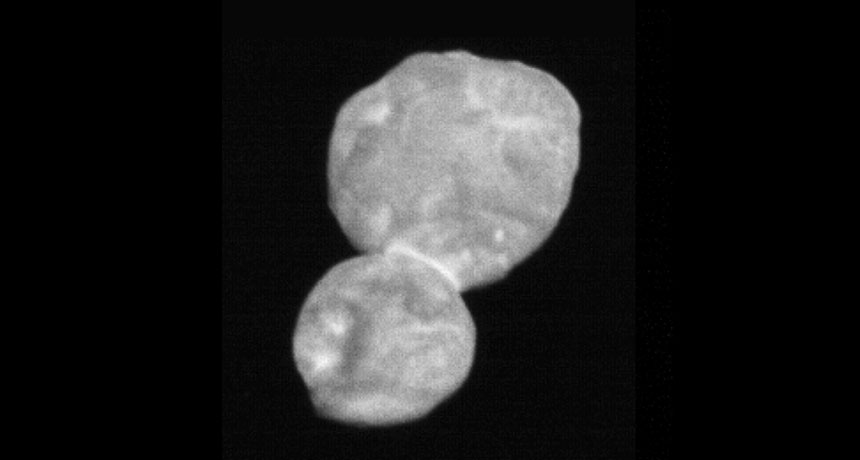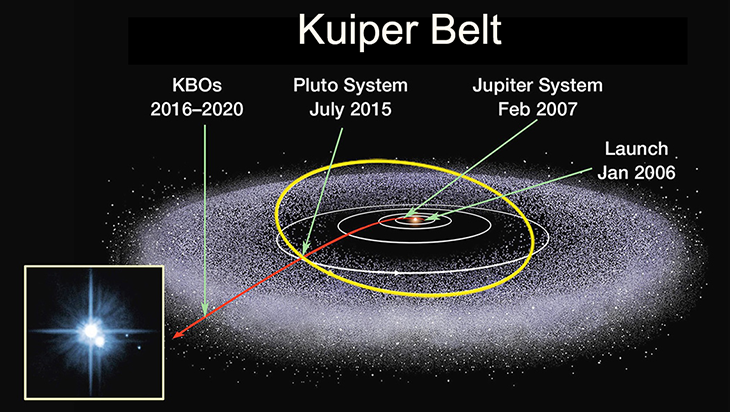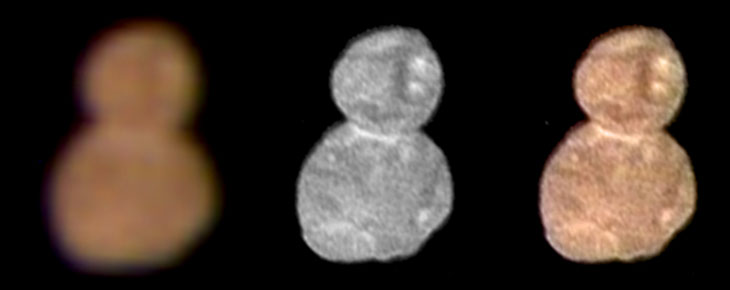There’s a snowman in space
The distant object, called Ultima Thule, is probably a conglomeration of rocky debris

This New Horizons spacecraft took this image at a distance of about 28,000 kilometers (17,400 miles). It shows the space rock’s unique shape.
SWRI/JHU-APL/NASA
On the far outskirts of the solar system lies a zone of very-distant objects revolving around our sun. It’s the Kuiper (KY-per) Belt. And this past New Year’s Day, a NASA spacecraft got a good snapshot of a snowman-shaped object there.
Nicknamed Ultima Thule, it’s known as a contact binary — or “two separate objects that are now joined together,” explained Alan Stern. And, he concluded, “It’s a snowman, if it’s anything at all.” (Twitter was quick to supply another analogy: the rolling BB-8 droid from Star Wars.)
Stern is a planetary scientist at the Southwest Research Institute in Boulder, Colo. He spoke January 2 in a news conference. It was held in Laurel, Md., at the Johns Hopkins University Applied Physics Laboratory. He described images that had just come back from the New Horizons spacecraft. It’s the same craft that snapped stunning close-ups of Pluto three years ago.
Ultima Thule’s snowman-like shape was a prized finding for planetary scientists. It supports the idea that planet-like bodies can grow from a slow clumping of small rocks. Ultima Thule seems to have done this. The space rock’s official name is 2014 MU69. Scientists actually think it may be one of the oldest and least-altered objects in the solar system. So, knowing how it formed might reveal how some planets formed.

“Think of New Horizons as a time machine,” says Jeff Moore. He is a planetary scientist at NASA’s Ames Research Center in Moffett Field, Calif. This spacecraft “has brought us back to the very beginning of solar system history — to a place where we can observe the most primordial building blocks of the planets.” Moore leads the New Horizons’ geology team. “It’s gratifying to see these perfectly formed contact binaries in their native habitat,” he says. “Our ideas of how these things form seem to be somewhat [supported] by these observations.”
Making sense of the photos
The pictures show the space rock from a distance of about 28,000 kilometers (17,400 miles). They reveal that MU69 is about 31 kilometers (19 miles) long. It has two round lobes, one about three times the size of the other. The spheres are connected by a narrow “neck.” That neck appears brighter than much of the rest of the rock.
The bright neck could be explained by small grains of surface material rolling downhill to settle there. Small grains tend to reflect more light than do large ones, explains Cathy Olkin. She is New Horizons deputy project scientist. She, too, works at the Southwest Research Institute. Even the brightest areas reflect only about one-eighth of the sunlight that hits them. The darkest reflect just 6 percent. (That’s about the same brightness as potting soil.)
Measurements also show that MU69 rotates once every 15 hours, give or take an hour. That’s a Goldilocks rotation speed, Olkin said. If it spun too fast, the odd-shaped rock would break apart. Fifteen hours is just right, she said.
The scientists also think each lobe’s round shape results from small rocks having glommed together to form bigger ones, Moore said. The collisions between the rocks likely happened very slowly. This would have let the rocks stick together rather than smashing into bits. The final collision was between the two spheres, which the team dubbed “Ultima” (the bigger one) and “Thule” (the smaller one).
That collision probably took place at no more than a few kilometers (miles) per hour. That’s “the speed at which you might park your car in a parking space,” Moore said. “If you had a collision with another car at those speeds, you may not even bother to fill out the insurance forms.”
New Horizons shows MU69’s color as reddish. The science team thinks the rusty hue comes from radiation that altered exotic ice. That ice would be some frozen material such as methane or nitrogen, not water. The scientists don’t, however, yet know what that ice is made from.
New Horizons is still sending data back to Earth. And, it will continue transmitting details of the flyby for the next 20 months. The data should soon reveal details of the space rock’s surface.








